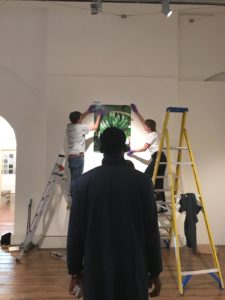GENERATIONS: Connecting Across Time and Place is now open – but how did it become the space you can visit today? Find out with a sneak peek of the installation process in this post.
That’s it: we did it. Our annual class exhibition is now open. As part of the installation team, I could not be prouder of what we have achieved, especially after spending almost two weeks in the space, watching it be filled with artworks, benches, labels and engaging feedback wall. There’s a lot more to installing an exhibition than I originally thought: it begins the moment you get to know the works and can see relationships forming between them. Installation involves everything from perfectly visualizing the exhibition space, to exchanging a lot of emails with contractors and screwing tiny screws into the walls. Let’s break it down.
For the Installation team (Katie, Valeria and I), the hard work began a little later than for the other groups. While we were waiting for all the correct information on the artworks (media and sizes, mostly) as well as instructions from the two main institutions we were working with (Arts Council Collection for loans and Somerset House for exhibition site), we began to create a virtual model of the exhibition. I really enjoyed playing around in Sketchup, a modelling software where you can scale a space and design endless scenarios of the displays we came up with in a whole-group brainstorming sessions. Not only was it fun to be able to simulate in real time and space what we were thinking, but it also gave us at least a small sense of what our exhibition could look like. ‘But be cautious’, our course leader Martin warned, ‘and never trust a simulated space entirely. The reality is always quite different.’
And he was right. On May 28, it was go time. We contacted and planned all kinds of transportation and deliveries, construction, artwork hanging, audio-visual equipment,and so on – now that we were as prepared as we could be, we had to keep our fingers crossed that everything would go smoothly. Thanks to the help of the Arts Council Collection handlers and the Courtauld Gallery conservators and registrar, the overall installation went without a hitch – we were even ahead of schedule! It was very important to follow this schedule as each day was dedicated to a specific aspect of the installation process: one day was devoted condition checking the artwork (a necessary step for their protection), another to hanging them, another to taking delivery of gallery furniture, another to installing the A/V equipment, and yet another to adjusting the lights and placing wall texts and labels.
On another note, here’s a reason why Sketchup is not to be fully trusted: the ambient lighting in the first room of the exhibition space proved to be much too bright in the afternoon and could endanger some light sensitive artworks (particularly the photographs). This apparently small setback was actually major in the condition for opening the exhibition, and we had to think quick on how to fix and blind the windows.
We also had the chance to include one of the exhibiting artists in the installation process: Appau Jnr Boakye-Yiadom came to help install Plantain Drop, a multi-media work (a print and a video). It was very interesting for us to see the artist working with his own piece in relation to other artworks, the space and the light.
In the end, everything is surely not perfect, as all the requirements, short time-span and few setbacks were all new to us – but for our first exhibition, we are all very satisfied with how the space turned out : it is a beautifully crafted exhibition with compelling artworks. Alas! It is not over for us yet, after installation inevitably comes… the deinstallation!

Appau Jnr Boakye-Yiadom in front of his artwork Plantain Drop being installed







